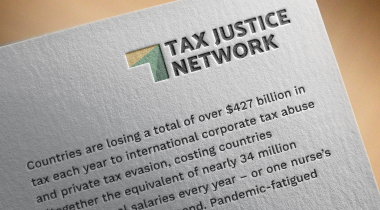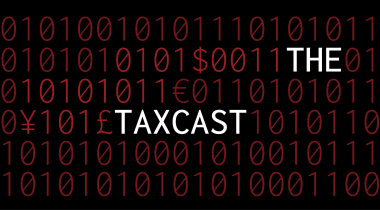
Nick Shaxson ■ Taxing Money Madness – now is the perfect time for FTT/Robin Hood tax

Taxing Money Madness — Why This Is A Perfect Time for a Robin Hood Levy on Financial Transactions
A guest blog for TJN by James S. Henry
If ever there was a perfect time to revisit the proposal to adopt a so-called “Robin Hood tax” (AKA the “financial transactions tax,” or the “Tobin tax“) and make it global, this is it.
In the last week we’ve just seen a very compelling reminder of why the Yale Prof. James Tobin (1972), a Nobel Laureate, and long before him, J.M. Keynes, a Cambridge don, were outspoken advocates of taxing financial transactions – in the case of Tobin, only currency purchase, but in the case of Keynes, all transactions in financial assets that might be subject to the speculative furies.
Their chief goal was financial stability. The idea was to “throw a little sand in the cogs of speculation, ” in order to rein in what they saw as one of modern capitalism’s most self-destructive tendencies. This is its periodic propensity to turn itself into a gigantic speculative casino, generating wild gyrations in asset prices that have nothing to do with their real economic value – and, indeed, may actually help to undermine real value, while scarring the BeJesus out of the rest of us. As Keynes argued in 1936.
“Speculators may do no harm as bubbles on a steady stream of enterprise. But the situation is serious when enterprise becomes the bubble on a whirlpool of speculation….(A) substantial transfer tax on all transactions might prove the most serviceable reform available…to mitigating the predominance of speculation over enterprise…” [1]
The Mainstream Case for FTT (Yawn)
Of course, the FTT has recently attracted many other supporters for other reasons beside Keynes-Tobin’s focus on money madness. [2]
For example, many supporters find the FTT attractive simply because it would be a good revenue generator – not unlike the global taxes on international airline tickets that have been in place since the 1970s. [3] From this standpoint, a global FTT would be an efficient, low-cost way of generating hundreds of billions of dollars that the planet urgently needs to pay the costs of fighting global problems like climate change, natural disasters, epidemics, and security threats. FTT advocates argue that it would be relatively painless to deduct just .05% to .1% of the gross asset value of financial transactions. The tax would apply to publicly-traded stocks, bonds, commodities, futures, derivatives and ETFs, as well as the $5-$6 trillion per day of foreign exchange trades, most of which are conducted in a handful of financial centers by a handful of giant banks. Given the immense size of these markets, even at those low percentages, FTT advocates argue that it might easily raise at least of $100 billion a year if it were implemented by major financial centers.
In addition, many advocates also see this particular tax as unusually progressive. While, in principle, the revenues would be channeled to all these worthy causes, the costs would be concentrated on a particular segment of the especially-undeserving that the rest of us, involuntarily, have come to know far too well since 2008 – banksters, LIBOR market riggers, currency market riggers, and high-frequency stock traders.
Naturally, all these arguments have been hotly contested by the financial services industry and its minions. However, FTT proponents appear to be winning the analytical side of the debate. But it is also fair to say that up to now, the idea has yet to catch on fire, especially given the opposition of key financial centers like Wall Street and the City of London. While proposals for an EU-wide FTT are on the table, and the FTT has even been discussed by the US Presidential candidate Bernie Sanders as a way to pay for his college tuition aid plan, politically speaking, a global FTT still has a very long way to go.
The China Syndrome
Until now. Perhaps the last three weeks of global stock market madness might help to break the logjam. Ever since China’s Central Bank decided to suddenly loosen its managed peg to the US dollar in mid-August, stock markets the world over have experienced wild gyrations way out of proportion to changes in economic fundamentals.
Last Friday, August 21, following several days of heavy losses on Shanghai’s market, European stocks fell sharply, and the Dow fell 525 points in the US, or 3 percent. On Monday, August 24, there was another 8.5% Shanghai market plunge. The Dow then fell like a stone, losing more than 1085 in its first 2 hours of trading, and forcing the exchange to halt trading entirely. Stock markets everywhere recorded similar sell-offs – all told, more than $3 trillion of market value was wiped out overnight, at least on paper.
But then markets rebounded sharply. As of Thursday, August 27, the Dow was just 2 percent below where it had been a week earlier, most of the world’s other 292 stock markets had also recovered sharply, and even Shanghai had rallied. Indeed, compared with a year ago, the Shanghai market is still 43 percent higher.
What’s been going on? Well, the disturbing fact is that all these wild gyrations are almost entirely utterly unrelated to “fundamentals” – the rational determinants of shareholder value like expected growth rates, profitability, and competitive position. For example,
- Some analysts tried to blamed the wild gyrations on a “currency war” initiated by China’s Central Bank with its mid-August 3 percent “devaluation” of the reminbi. In fact this was a drop in the bucket. Since 2005, when it shifted from a hard $US peg to a managed float, China has allowed its currency to appreciate against the $US (from 8 reminbi per $ to 6.4), even while the $US has also gained strength against most other currencies. The overall effect, for example, is that China’s currency has appreciated against the Japanese yen by more than 80 percent since 2013.
Contrary to right-wing China bashers (especially in the US), China’s latest moves are not part of a “currency war,” but an attempt to actually reduce its interventions the currency market – as the IMF has been requesting. If anything, given the desire to reverse capital flight, stimulate domestic consumption, open up its capital markets to foreign bond investors, and allow its currency to play a larger international role as a “reserve currency,” China’s preference is clearly to have have a stronger currency. While its Central Bank should have done a better job of telling the world what it was up to, this mild devaluation can’t explain the wild overreaction.
- Other analysts have blamed this week’s market madness on a variety of other domestic factors with respect to China – like its declining growth rate, the country’s soaring internal debt levels, the ups and downs of President Xi’s recent anti-corruption drive, and this year’s soaring capital flight. But “China doomsayers” have aware of all these factors for some time. They don’t come close to explaining this week’s wild ride.
- For example, while China’s stock market did indeed become overheated in 2014-2015, a correction was already well under way. Shanghai’s market index peaked in June 2015 (at 5166 on 6/12/15), after more than doubling in the past year (from 2052 on 6/12/2014). But by July 2 it was already down 24 percent (to 3912), and by July 31, another 6 percent (to 3664.) By last Monday, it had fallen another 16 percent, to the point where average price-earnings ratios are now about the same as in the US.
- Moreover, China’s economy is hardly in free-fall. The IMF’s latest forecast, issued just this week, is for a healthy 6.8 percent GDP growth rate over the next year, about the same as last year, and only slightly below the 7.2 percent recorded in 2013. Nor is the Shanghai stock market a good predictor of China’s growth rate – which makes sense, given that that market, now the world’s fifth largest, is notorious for its “Wild East,” margin-fueled, speculative ups and downs.
- Whatever has been going on in China’s economy, it should not have the dramatic impact that it did on the world’s stock markets, especially those in the US and Europe. For example, US exports to China now account for just .7 percent of US GDP.
Just this week we learned that US GDP growth in QII 2015 was proceeding at an annual rate of 2.7 percent, the highest growth rate since 2008. The US housing market is strong; energy prices are low; real interest rates are close to zero; the federal deficit is declining; corporate profitability has been setting records; and big banks are much less highly leveraged than they in the years preceding the financial crisis.
True, US stock markets have now had 6.5 years of steady growth, and investors always feel a little guilty when a winning streak has continued this long. But none of this justifies the 3 to 7 percent daily swings that we saw this week in US markets. And similar market madness has gone on almost everywhere else.
- The gap between market valuation and economic value were even more glaring at the level of individual companies. For example, it is true that Apple, the world’s most valuable tech company, has invested heavily in China. When the Shanghai stock market plumetted by 8.5 % last Monday, however, on total trading volume of around $70 billion, back in the US, Apple’s stock price fell by 13 percent in the first three hours of trading –about $70 billion of the company’s market value. At that point, then, perhaps the most successful, dynamic company in the history of capitalism was trading at less than 10 times earnings – compared with a 19 average for all US companies. And Apple’s stock price had fallen 23 percent in the previous two weeks – all because of China.
- All this led Apple’s CEO Tim Cook to call reporters and tell them that in fact Apple had just had its best two quarters ever for sales in China – despite all the Shanghai market ups and downs. He expected this trend to continue. And he tried also tried to explain that the “rebalancing” going on in China’s economy right now is likely to improve that country’s real stability and growth over the long run – where by far the largest portion of any company’s – or country’s – net present value is located.
Market Madness Components
Across all major markets, there have been many other similar stories of companies whose stock prices have just experienced a brutal disconnect between economic fundamentals and speculative mania. Keynes was absolutely right – market madness can produce contagions where the “enterprise becomes the bubble on a whirlpool of speculation.”
If this was true in the 1930s, it is even more so now.
- First, now we have many more powerful ways to speculate, with an extraordinary range of traded options, derivatives, commodities, futures, exchange-traded funds at our disposal, plus many ways of leveraging and hedging all such tranactions. It has gotten to the point where many of the smartest MIT math wizards and Harvard PhD economists no longer want to teach or work on real-world problems — they head to Wall Street to build quantitative trading models for hedge funds.
- Second, the power of trading all these speculative instruments is now amplified across at least 292 public stock markets in 153 countries, as well as markets for for currencies, commodity futures, and debt. In addition, there is also a growing number of “dark” markets not available to the public at large.
- Third, since the 1990s, we’ve seen the globalization of 7×24 financial news in almost every market, as well as instant mobile communications, Internet and data services, and mobile financial transactions of all kinds. A feather does not fall in Kinshasa without it being recorded and refracted around the planet as a potentially-tradable event. Citigroup used to say “The Citi never sleeps.” Now it is not just Citi. The whole remotely-connected world is on pins and needles, waiting for that event, and then instantly reacting before someone else does.
But this means there is never enough time for interpretation, nuance, in-depth investigation. “Long-term investing” becomes holding an asset any longer than it takes to find a buyer.
- Fourth, on top of all these other trends, there has also been the proliferation of so-called “high-frequency” securities trading, powered by ultra-fast networks and automatic computer trading algorithms, as ably described by Michael Lewis.[4] This now account for at least 84 percent of all stock trades in the US, 77 percent in the UK, and a rising share in other markets as well. [5] Ownership of these systems is reported dominated by our old friends, Wall Street investment banks (61%) and hedge funds (24%).[6]
Indeed, consistent with this, US retail brokers report that on Monday, August 24, high-frequency automatic trading programs accounted for almost all of the trades reflected in 1085-point Dow Jones downdraft, before trading was halted. Retail brokers watched from the sidelines, unable to break into to the trade flow, as one automated program after another followed the rest of the market down, robotically. At that point, in a sense, the entire New York Stock Exchange had been replaced by a very fast,utterly unconscious computer algorithm.
Fast Capitalism
The combination of all four factors just described leads to a degenerate form of free enterprise we will call “fast capitalism,” a generalization of the “fast food” and “fast fashion” concepts to the world of finance. If the folk hero of conventional, “slow capitalism” is the Ayn Rand’s John Galt-type entrepreneur, the business innovator and builder, the folk hero of fast capitalism is the trader/ speculator. The full specification of the contrasts between these really two quite different systems is interesting and important, but we have to leave that for another occasion.
Reframing the Case for the FTT
In any case, by now we have at least begun to gather the firewood that will be needed for another attempt to light a new, slightly different kind of political fire under the FTT. Rather than merely emphasizing FTT’s revenue-generating potential, let’s argue that the kind of speculative excesses just witnessed in the China case, while severe, are not unique, and that they may be avoidable. On the other hand, they might well also be a harbinger of even worse to come, if “fast capitalism” is allowed to extend its reach, underregulated and undertaxed.
From this angle, the kind of extravagant price fluctuations, way out of proportion to value, that were witnessed in this week’s China madness are just another kind of market “externality” that deserves to be taxed, so that the “polluters” – in this case, heavy traders – have to pay.
When it comes to criticizing capitalism, the Left’s traditional focus has been on so-called “objective” structural factors like “inequality,” “unemployment,” and “poverty” that, at least in principle, can be measured and counted.
In contrast, with respect to the problems described here, we have focused on capitalism as a lived experience — on how it actually feels to live in a society that is subjected to such utterly pointless ups and downs.
The global trading system described here fails not only because it doesn’t make us all rich, “successful,” employed, and well-fed. It fails because it doesn’t make us feel content, fulfilled, or secure. And that insecurity will persist, even if, on average, the system continues to expand.
***
[1] J.M Keynes (1936), The General Theory of Money, Interest, and Employment. (Cambridge U., 1936), 104-105.
[2] See https://en.wikipedia.org/wiki/Tobin_tax#Is_there_an_optimum_Tobin_tax_rate.3F.
[3] See https://www.globalpolicy.org/global-taxes/aviation-taxes.html.
[4] See Michael Lewis, Flash Boys (W.W. Norton, 2014).
[5] See http://www.washingtonsblog.com/2012/04/84-of-all-stock-trades-are-by-high-frequency-computers-only-16-are-done-by-humans.html.
[6] See See also http://www.businessinsider.com/barclays-just-got-lawsuits-triggered-by-flash-boys-book-thrown-out-of-court-2015-8?r=UK&IR=T.; http://www.esma.europa.eu/system/files/esma20141_-_hft_activity_in_eu_equity_markets.pdf.
Related articles

The Financial Secrecy Index, a cherished tool for policy research across the globe

New Tax Justice Network podcast website launched!

Como impostos podem promover reparação: the Tax Justice Network Portuguese podcast #54

Convenção na ONU pode conter $480 bi de abusos fiscais #52: the Tax Justice Network Portuguese podcast

As armadilhas das criptomoedas #50: the Tax Justice Network Portuguese podcast

The finance curse and the ‘Panama’ Papers

Monopolies and market power: the Tax Justice Network podcast, the Taxcast

Tax Justice Network Arabic podcast #65: كيف إستحوذ الصندوق السيادي السعودي على مجموعة مستشفيات كليوباترا

Remunicipalización: el poder municipal: January 2023 Spanish language tax justice podcast, Justicia ImPositiva




Complementary reading in addition to the ECB report – OTC derivatives and post-trading infrastructures Sep 2009
A Secretive Banking Elite Rules Trading in Derivatives – By LOUISE STORY – Business Day – NYT – December 11, 2010
How Wall Street captured Washington’s effort to rein in banks – By Charles Levinson – Reuters – Filed April 9, 2015, 2:30 p.m. GMT
US banks moved billions of dollars in trades beyond Washingtons reach Part 2 – By Charles Levinson – Reuters – Filed Aug. 21, 2015, 2 p.m. GMT
The “profitability” of the real economy and the comparative time scales mean that OTC “speculation”, both on- and off-shore with all that that implies, is both higher and “untaxed” to the detriment of physical economy investments and employment.
Apologies for the (limited) www links
Thanks: funnily enough, we’ve already written a blog based heavily on exactly these two stories – we just haven’t pressed ‘publish’ yet since we’re waiting for an editor. Meanwhile, we have written large amounts of stuff along these lines in the past, here https://www.taxjustice.net/topics/finance-sector/tax-havens-financial-crisis/